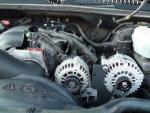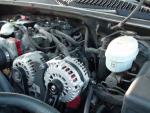-
Posts
194 -
Joined
-
Last visited
-
Days Won
1
Content Type
Profiles
Forums
Events
Gallery
Store
Posts posted by highvoltamps
-
-
Well I am torn down and ready to install am amp rack. What do I do with the cab vents??
You can make little ducts and ducted to the sides or reuse the stock rubber duct and reverse it if your not worried about presentation . That's what I have to do with my setup. Going to dynamat and ensolite the inside of aluminum ducts to reduce outside noise.
Just analzed my vents with the trims and going to duct to the sides and down, the depth staying tight to the trim pieces. Going to be competing and the little things count. Plus I love doing this shit. Check out the progress http://s1142.photobucket.com/albums/n616/highvoltamps/
-
Instead of the JL 10WX-4, go with the 10W6V2. Same sealed enclosure size at .625 cu.ft. and will hit a lot harder.
-
Note: the outside marker leds need load resistors on them too. They are a 25 Ohm, 25 Watt.
-
The speed sensor is located on the transfer case if its 4wd and on the trans for 2wd. The two wires run to the pcm in the engine bay.
where is the speed sensor signal circuit?
-
Make sure your brake lights are working and if LED's use resistors or LM487 electronic flasher. Also make sure there are no car audio wires are running close to the speed senor signal circuit, this will induce EMI and may cause erratic operation.
-
-
Here are the king kong sunflowers I did last year. I used advanced nutrients and super thrive with a daily watering. They were bad ass but a lot of work, especially battling the squirals and birds. If I do they again they will be spaced out more in the back yard and build a netted greenhouse when they start budding. Ended up with about 8 good heads that I dried, soaked and roasted. All the little heads I dried over the winter and when those damn squirrals came back out, I had some target practice. Got pretty good with the blow dart gun.

-
I got mine from Nations, top quality and good customer service. http://www.nationsautoelectric.com/ Check these out http://www.nationsautoelectric.com/ad-244.html I got the AD-350-SP with the external regulator and dual bracket. Very easy install but had to put a clutched pulley on the new alternator because it sqeeled at a high rpm shift.
-
just an air hammer. it will take the nut right off. been there done that. dont worry about that shaft. it may move a smidge but not enough to keep the air tool from doing its job. Quick and painless.
Good deal, thanks bro
-
Just hit it with an air impact and the nut comes right off. Its simple.
What's going to hold the shaft? Don't want to damage the alternator..
-
I have to install a clutched pulley for my dual alternator setup because it squeels at a high rpm shift. The shaft is a torks the has to be held stationary while the nut is removed. Thanks for any help.
-
Most likely the pin.....
Thanks again.
-
Here's another part of the alarm I thought you might like. http://amazing1.com/ultra.htm Scroll down to the Phasor Pain and Shock Field. I'm planning to wire this into the siren output via relay and mount the speakers on the rear pillars.
-
Yes, sand them lightly with 80 grit sandpaper and repeat the bedding process with the freshly cut rotors.....
Thanks good buddy. Since you know your brakes, I got one more for you. The shop that did my brakes used an air gun to tighten the caliper bolts and now the the one side both spin when tightened. I have to put channels around the pin and tighten the bolts. Is this bad pins or the caliper?
-
Doesn't take much, 1 day of stop and go driving will do it....
Good to know thanks. That makes sense, since I changed the pads and rotors on the front at the same time and had no problems. I'm going to get the rotors resurfaced. Do you think I can salvage the pads by sanding them down flat?
-
That makes sense. I knew a fuse took double it's load before it trips, but i didn't know about the 'crest factor'. I usually do fuse my system a little on the small size, and they never blow.
Not all fuses are like that, the slow blow would be that particular fuse. There are also current limiting, time delay and fast acting type fuses. I spoke with Stinger and the use slow blow on the anl type fuses.
-
I think you arleady figured out your answer, as you stated, you should have cut the rotors before installing the new pads. New pads + old scored/warped/worn rotor surface = noise, glazing, improper pad bedding, and premature pad wear......
Yeah but do you think they can already be messed up after 3 weeks of use with the old pads. I took a sanding block with 120 grit and took of the old transfer film and they looked near new again.
-
Oh no, the rear brake squeal is back but not as bad. I noticed the wear is mainly on the middle of the rotor with some scoring marks but still smooth. Think the squealing is brake dust from an uneven surface on the rotor. Should have waited to put the new pads on with the new rotors. I think I need the rotors resufaced from the old pads not wearing flat or I need new calipers or new brake pads. Just don't understand why the front has the same setup and has not made any noise and the rotor wear is even from top to bottom.
-
Hope so. Off the alarms, I came across this from the IASCA rule book. Thought you might like. Going to fuse my alternator at 250 amps after reading this.
A fuse is required to carry its rated load continuously, 135% of rated load for 1 hour,
and double its rated load for 30 seconds. So, if a 500 amp fuse is used and the
cable shorts to ground, it must generate 1,000 amps of current through the short to
blow the fuse quickly, which isn't likely. Using too large a fuse is potentially very
dangerous!
THE CREST FACTOR
Now that we know the basics of a fuse, how does it apply to use with audio
equipment? To understand how it applies, we need to know about the Crest Factor.
The Crest factor is simply the ratio of the peak signal level to the average signal
level. An un-clipped sine wave has a crest factor of 3 dB (i.e. the peak level is double
the power of the average level). Pink noise has a crest factor of 6 dB (the peak level
is 4 times the power of the average level). For every 3 dB increase in the crest
factor, the power level is divided by 2.
A crest factor of 10 dB means the peak power is 10 times the average power. 20 dB
yields a peak power of 100 times the average. And a 30 dB crest factor yields a
peak power 1,000 times the average!
Most music has a crest factor between 10 and 20 dB. Some of the newer popular
recordings unfortunately have very low crest factors, often less than 10 dB. Music
with a very low crest factor is not dynamic, has little impact, and typically sounds
loud all the time.
Music that is very well recorded will have crest factors above 15 dB, and sometimes
well into the 20+ dB range. (The James Newton Howard and Friends recording from
Sheffield Labs has a 30 dB crest factor).
Now, amplifiers are rated at an RMS power output, which is simply the average
output when reproducing an un-distorted sine wave. Since a sine wave has a crest
factor of 3 dB, a 1,000 watt RMS rated amplifier will reproduce 2,000 watt peaks
cleanly.
Now, let's take this 1,000 watt amplifier being driven to its maximum un-distorted
output level of 2,000 watts with a music track having a crest factor of 20 dB. 2,000
watts divided by 100 = 20 watts average power output. If the crest factor is dropped
to 10 dB, then the average power output will be 200 watts. And if really poorly
recorded music is used with a crest factor of only 6 dB, the average power output
would be 500 watts. So as you can see, the actual power output of an amplifier
reproducing music is nowhere near the theoretical maximum output. It may be as
high as 1/2 the rated output with really poor recordings, but will likely be much less
than this.
NOTE: This does not apply to SPL competition, where amplifiers are typically driven
to their maximum output with sine waves, and are often driven into substantial
clipping as well.
With the crest factor considerations in mind, I would suggest the following:
First, a maximum allowable fuse value can be calculated based simply on adding up
the recommended fuse values for all the amplifiers, any larger than this would be
grounds for points deductions or disqualification. And quite honestly, this would be
severe overkill on the main system fuse anyway.
A more precise fuse rating can be calculated using the following method:
Determine the maximum peak power output of each amplifier by multiplying the
rated RMS power by a factor of two.
Allow for the efficiency of each amplifier. For class-A/B amplifiers, assume
60% efficient, and for switching or class-D amplifiers, assume 80%.
Assume supply voltage is 12 volts (This can be argued to be higher or lower,
depending on the system, but 12 volts is a good average)
Assume a worst case music crest factor of 6 dB, which means the average
output power is 1/4 of the peak output.
(continued next page)
Calculation Example:
A system has (3) 1,000 watt Class-D amps, (2) 500 watt class-A/B amps, and (2)
150 watt class-A/B amps.
The recommended fuse values for the amplifiers are as follows:
1,000 watt amplifiers - 100 amps each
500 watt amplifiers - 70 amps each
150 watt amplifiers - 25 amps each
The maximum allowable main system fuse size would be:
(100 amp X 3) + (75 amp X 2) + (25 amp X 2) = 500 amp
Now calculate the fuse value with peak outputs utilizing Crest factors:
The maximum peak outputs will be the RMS outputs multiplied by 2 to get the peak
output for each amplifier:
1,000 watts X 2 = 2,000 watts
500 watts X 2 = 1,000 watts
150 watts X 2 = 300 watts
Taking efficiency into account:
2,000 / 0.8 = 2,500 watts
1,000 / 0.6 = 1,667 watts
300 / 0.6 = 500 watts
So the total power draw for the amplifiers would be:
2,500 X 3 amplifiers = 7,500 watts
1,667 X 2 amplifiers = 3,334 watts
500 X 2 amplifiers = 1,000 watts
The total power required for all the amplifiers to be driven to maximum peak output
simultaneously would be 11,834 watts.
Now, take the 6 dB crest factor into account by simply dividing the above peak
output by 4:
11,834 / 4 = 2959 watts
Now divide this by 12 volts: 2959 / 12 = 247 amps
A 250 amp fuse would be a much more realistic value than the 500 amp fuse that
would be required by adding the recommended fuse values for all the amplifiers.
Notice that for a crest factor of 6 dB, the fuse value would be approximately 1/2 that
of the fuse calculated by adding the recommended fuses together. If the crest factor
is 9 dB, the fuse value would be 1/4, and for a crest factor of 15 dB, the fuse value
would be 1/16th.
I have tested this technique, and have never had a problem burning a main fuse
calculated simply by adding the ratings of all the amplifiers and dividing by two. This
is the same as going through the entire calculation for a crest factor of 6 dB.
I know going through the entire calculation is somewhat confusing, and may be
difficult to fully explain in the rule book, but this is how it works. And, using a fuse as
large as that calculated by simply adding up the recommended fuses values for each
amplifier will be overkill, and could even be dangerous.
-
Nice, what do you think about the alarm? I hope it will be as good or better than the DEI Automate installed now..
-
I'm not familiar with that part#(vg800).
Good to hear it's coming together.
The Scytek VG800 manual I posted for you.
-
Because the motor wires rest at ground, i don't think you can just pulse the wire with current. You could hook up some relays to break the motor wires when the module is triggered, that way your windows would still work like factory and still have the windows roll down.
Nice, I was thinking the same with adding the relays. Thanks for the explanation. Some of the alarm wiring can be very tricky. Got to draw it out on paper before I attempt anything. What do you think about the VG800? Pretty self explanitory with a lot of options. Should be easy since I have an aftermarket already installed. Looking to run multi conductor cable to all of the locations to tap and terminated in the center concole under the bucket. Going to remove the factory amp for mounting the alarm equipment. In the center console storage will be the keyed valet switch. My daughter and I finished the polished aluminum center console control panel and head unit/EQ face over the weekend. I came out to a mirror finish like the amp rack, getting excited. All I got left is dynamat/ensolite, running the wires, mounting equipment, termination and a RTA tune.
-
Good to know, I like that feature. Here's the manual to the WR-16 http://www.megatroni...BLACKManual.pdf and the alarm manual http://www.scytek.ne.../astra/a777.pdf You have helped me out, let me know if I can help you out with any electrical questions. Sounds like your knowledgeable in electricity but it doesn't hurt to offer.
-
I ended up buying the XK01, not to worried about the heated seats but definitely want the window rollup to work. I have the Scytek WR-16 smart window control module that can do 2 windows roll-up and down. On the schematic its wired to the door switches, but when the key is not in the ignition or not auto started this will not work. Should I just use the XK01 for the windows but can I roll down thw windows with this module?

















Got The Front Growl
in AWD, Differential, & Transmission Tech
Posted
Got it from west coast differentials, you can call them and they will get you set up with the right kit.